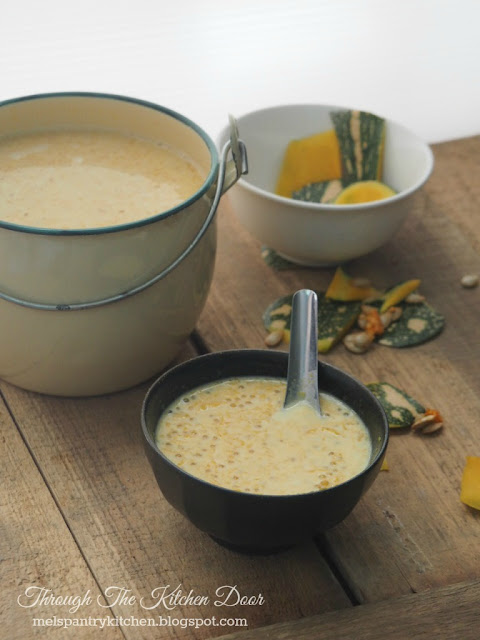Two years ago I have succeeded baked my first Castella Cake eventhough I don't have that wooden mould at that time. After my success in this cake, I even have modified the cake into a Coffee Castella flavour and I really love it!!
When Zoe of Bake For Happy Kids posted her Castella Cake recently, the word "Best & Fail Proof" just caught my eyes and I would love to try this out as this recipe has an added ingredient of oil inside. Im sure with the added oil would moisten the texture of the cake more and sure enough!
When I bite my first bite of the cake, I was like in cake heaven.... OMG... it was so so so so delicious!!!
The Best Japanese Castella Cake
Recipe sourced from Bake For Happy Kids
Ingredients
Egg yolk mixture
Egg yolk mixture
115g
bread flour
45g egg yolks (about 3 medium size egg yolks) at room temperature
60g caster sugar
50g milk
40g honey (or 2 tbsp) honey
30g vegetable oil
Egg white mixture
105g egg whites (about 3 medium size egg whites), at room temperature
60g caster sugar
45g egg yolks (about 3 medium size egg yolks) at room temperature
60g caster sugar
50g milk
40g honey (or 2 tbsp) honey
30g vegetable oil
Egg white mixture
105g egg whites (about 3 medium size egg whites), at room temperature
60g caster sugar
Method
Place a baking rack in the middle of the oven. Preheat oven to 180°C / 350°F with NO fan forced.
Line the internal sides of your castella wooden mould with grease proof paper and wrap around the bottom of the mould to just above 1” height.
Place a baking rack in the middle of the oven. Preheat oven to 180°C / 350°F with NO fan forced.
Line the internal sides of your castella wooden mould with grease proof paper and wrap around the bottom of the mould to just above 1” height.
(If you
are using a metal loaf pan, fully lined the inside of the loaf pan with
aluminium foil then line again another layer with greaseproof paper.)
Preparing for the egg yolk mixture:
Place the milk, honey and oil in a small saucepan or heat proof bowl. Heat the mixture in the saucepan with low heat under the stove or microwave mixture in the heat proof bowl with short pulses of low power until the honey dissolves into the mixture. Do not let the mixture boils because the mixture will cause to curd. Set aside for the mixture to cool slightly, about 10 minutes.
Place egg yolks and sugar in a large mixing bowl and using your hand whisk, whisk the mixture turns pale in colour. Whisk in the honey mixture. Sift the bread flour into egg yolk mixture and whisk until everything is combined. Set aside.
And for the egg white mixture:
Using your stand mixer or hand held mixer with a whisk attachment, beat egg whites in medium low speed until foamy. Increase beating speed to medium and while beating, add in sugar gradually and continue to beat until stiff peaks form and the meringue look glossy. Do not over beat the mixture.
Using a hand whisk or a spatula, fold in 1/3 of the egg whites to the egg yolks mixture. You can vigorously mixture the batter together in this stage but after the rest of the egg whites, please fold in with your spatula gently till no egg white lumps are visible.
Slowly pour batter into the prepared pan at about 1 feet high. Smoothen the surface and ently drop the pan onto the kitchen bench from a height of 10 cm to remove any large air bubbles and do this just once. If you are afraid of doing this, you can use a skewer to draw a zigzag to remove air bubbles in the batter. You can choose to do either one of these steps or both but do not over-do these steps.
Place pan in the middle rack and bake for 10 mins. Decrease temperature to 140°C / 285°F and bake for another 60 mins, or until the cake is thoroughly cooked and must has a nice golden brown top.
NOTE: As all oven temperature differs, please adjust the temperature and timing accordingly.
Remove the cake out from oven and invert the cake to a chopping board for 5 minutes. Remove the wooden mould out and invert back the cake to another plate or a wooden board. Once the cake slightly cool to touch, peel off the baking paper and wrap the cake in plastic wrap. Place cake in an airtight container or a zip lock bag and allow it to rest in room temperature to let the cake moisten for at least one day. (The cake taste best after it aged a day).
I think I have done good this time and will stick this recipe for life ..... hahaha! Look how good the texture of this cake.... it is not crumbly at all ... very spongy absolutely loving it!
This is how I lined my wooden mould.
Alternatively, if you do not have the wooden mould, you may use the normal pan and lined the pan like the below two pictures.
Wrap the pan with aluminium foil in 2 layers and lined another layer with grease proof paper.
Using two square pans of 8" and 9", cut out some cardboards and wrap with aluminium foil and slot in between the two pans. The inner small pan, please lined the bottom with grease proof paper (as I have forgotten to cut out the paper to place in to take photo).
* If you are using the above two method of pans to bake the castella cake the timing should be shorter about 45 to 50 minutes. Like I said earlier, different oven temperature would result to different timing too.
So what are you waiting for? Try it ...




























